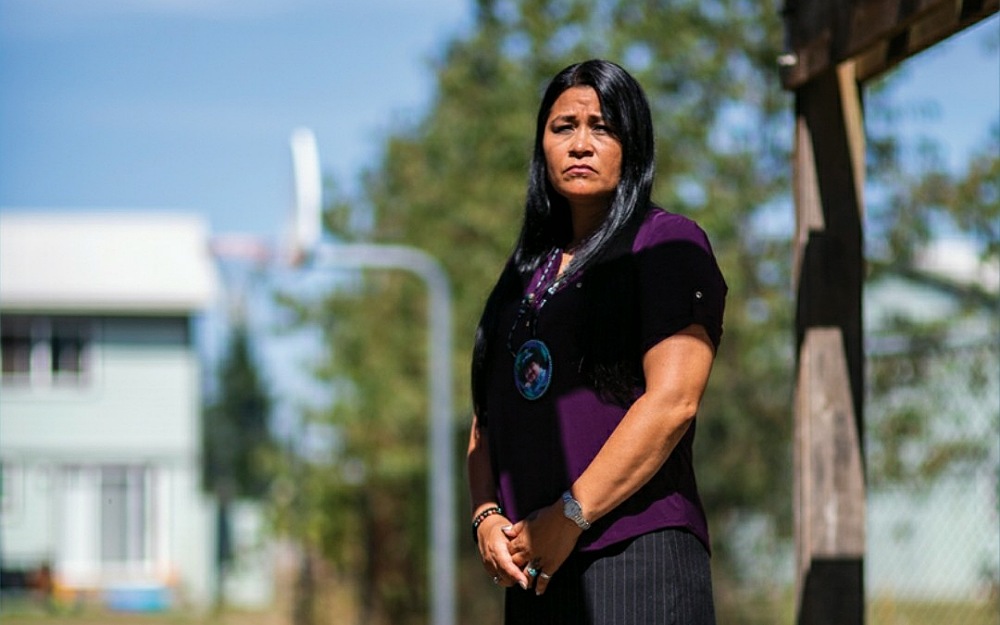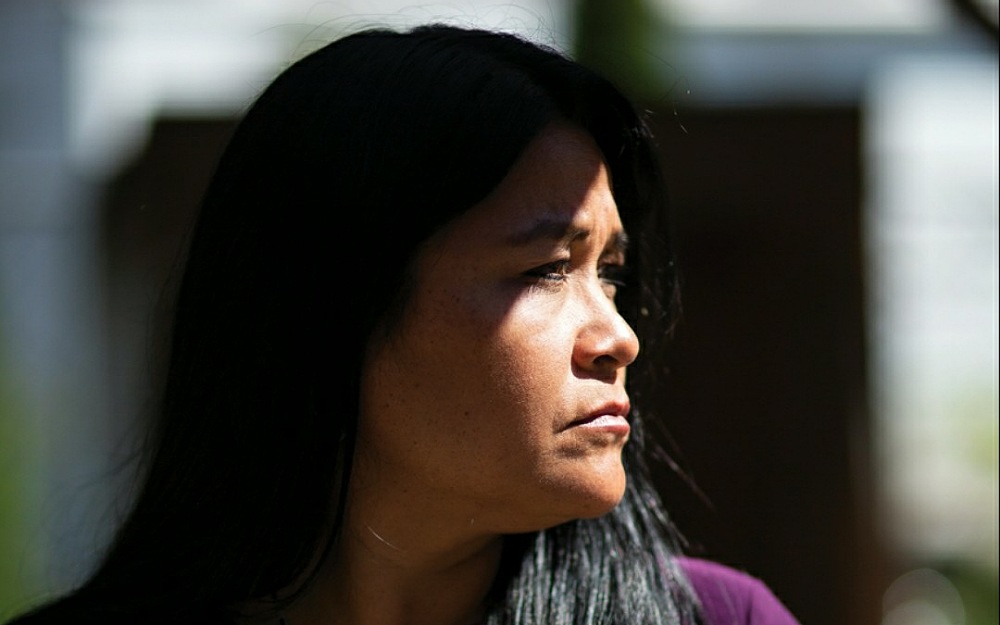How a burglary, social media and politics led to a Nooksack Tribal Councilwoman being bullied out of office
Jane C. Hu/High Country News

The lingerie photo was Carmen Tageant’s breaking point. Sixteen years earlier, she’d taken a set of boudoir photos as a Valentine’s Day gift for her partner. But as life happened — raising seven children, going back to school, achieving a spot on the Nooksack Tribal Council — she’d all but forgotten about them. So when she checked her Facebook notifications one morning in February 2016, she was shocked.
An image of Tageant posing with her legs in the air had been posted by someone named Keith Williams, and the accompanying text made it clear the post was intended to shame: “We all now know how we got her votes for (sic) in office and has nothing to hide!” It was soon posted to a Nooksack Facebook group by another user. Tribal citizens jumped in with dozens of comments, making it painfully obvious to Tageant that her picture was making the rounds. “Lol she’s shameful,” one person wrote. “Spreading lies and legs,” wrote another. And a third attacked Tageant’s leadership credentials: “Who is going to support a liar … A cheat … I will not support a person like Carmen T and I don’t think our true tribal membership should either.”
“I was a tribal leader, thinking, ‘I can handle it, I have thick skin,’ ” Tageant says. Still, she locked herself in her room for the rest of the day. Embarrassment gave way to fear when she considered how the photos might impact her family’s safety. A few weeks earlier, someone had broken into her home, and the violation had shaken her. Her mind reeled as she realized that the burglar must have stolen those photos. She checked her album, and sure enough, four of the boudoir shots were missing. Did that mean that “Keith Williams” was the thief? She didn’t know anyone by that name, and that struck her as suspicious; during the 20 years she’d lived in Everson, Washington, and worked for the Nooksack tribe, she’d met nearly everyone in the community.

Tageant grew up on Bainbridge Island, a short ferry ride away from Seattle. As a child, she often traveled north to the Nooksack Reservation with her grandma and her mother. After a short stint at a tribal college in Kansas, Tageant returned to Nooksack territory. “I came back and got pregnant with my first child. … I wanted them to know their culture,” she says.
The reservation itself is just four buildings on a one-acre parcel in northern Washington, tucked into a U-shaped dip of the Nooksack River. Much of the tribe’s activity takes place on the constellation of trust lands it maintains nearby. About half of the tribe’s 2,000 members live in the rolling foothills of Mount Baker, on traditional Nooksack territory. Tageant quickly found her place in the community,working as a receptionist in administration and a clerk at the tribe’s social services office, then doing public relations work for the tribe before moving into advocacy work. There, she assisted victims of domestic violence and addiction, and connected families with food stamps, energy credits and parenting classes. “I wanted to help everybody I could,” Tageant said. After nearly a decade of public service, Tageant won a seat on the Nooksack Tribal Council in 2004 and was elected again in March 2014.
But conflict began shortly before Tageant’s second term. In early 2013, the tribal council voted to invalidate the enrollment of descendants of a Nooksack woman named Annie George. According to the tribe’s Constitution, people can apply for enrollment if they’re direct descendants of a member who received an original land allotment. They can also apply if they’re descended from a member who appeared on a 1942 official tribal census roll or received a federal payment in the 1960s, provided they meet a one-fourth-degree blood quantum or are adopted by an enrolled member or the tribe itself. Annie George, the council alleged, did not appear on that 1942 census or receive a land allotment, and therefore any members enrolled through their relationship to her were “erroneously enrolled.” By Valentine’s Day 2013, letters had been sent to 306 Nooksack people, informing them that their citizenship would be revoked within 30 days, unless they requested a meeting to dispute the decision.
Tageant was not among the disenrollees, who came to be known as the Nooksack 306, but she was outspoken in her support for them
Tageant was not among the disenrollees, who came to be known as the Nooksack 306, but she was outspoken in her support for them. “When my picture was placed on Facebook, I was standing up vocally” against disenrollment, she says. On Facebook, Keith Williams slammed Tageant and her support for the 306, urging tribal members to recall her from the council. When Tageant noted, on Williams’ page, that she had reported the attacks to county authorities, Williams appeared undeterred: “Whatcom (County) detectives come arrest me for speaking the truth!”
Meanwhile, other men saw the photo as an invitation: “I had men messaging me, asking me for sex, making rude comments,” says Tageant. Little did she know, the digital intimidation was just the beginning of what would become a full-on assault on her reputation.
TAGEANT’S DIGITAL HARASSMENT was a new outlet for old tensions in the Nooksack community. Long before that lingerie photo, or before the council’s move to disenroll the 306 in 2013, there were growing resentments between families. Williams alluded to this in a February 2016 post: “I know everyone is tired of the 306 drama, but some of our Nooksack people have waited 30 years for this.”
The roots of the conflict stretch back to the 1920s and ’30s, when Nooksack families moved to Bainbridge Island for farm work. Around the same time, the area saw an influx of Filipino immigrants. Some Filipino men married Indigenous women, and many of their descendants, who call themselves “Indipinos,”returned to their ancestral land in the 1980s at the tribe’s urging and enrolled as members. By the late 1990s and early 2000s, the Rabangs, an Indipino family, dominated the tribal council, and other Nooksack families were not pleased. In a 2000 Associated Press story, tribal elders called the Rabangs “outsiders” who exploited “lax membership rules” in the ’80s to “infiltrate” the tribe. There was an attempt to disenroll the Rabangs through an enrollment review, but it failed after “more than 100 angry Rabangs confronted the council,” according to the AP.
Since the 1990s, there’s been a “surge” of disenrollment among tribal nations, says David Wilkins, a citizen of the Lumbee Tribe of North Carolina and co-author of Dismembered: Native Disenrollment and the Battle for Human Rights. While there are no official statistics, Wilkins estimates that as many as 8,000 individuals from up to 85 tribes have been affected. In a 2014 Associated Press story, a member facing disenrollment from the Confederated Tribes of the Grand Ronde spoke of being “culturally homeless.” The consequences are practical, too, as disenrollment eliminates people’s access to tribal housing, healthcare and other social services. Tageant, whose grandfather was Filipino, says some tribal elders resented the interracial families. “They didn’t like the ‘mixed breed,’ ” she says. After the Rabangs fell from power in the 2010s, the council again moved in 2013 to invalidate their enrollments. It would be easy to conclude the disenrollment of the 306 is racially motivated; all the disenrollees come from Indipino families. But the reality is more complicated: Some of the disenrollment supporters also come from interracial families.But the reality is more complicated: Some of the disenrollment supporters also come from interracial families. The 306 say the effort is driven not only by anti-
Filipino sentiments, but also by a hunger for power and the desire to share limited resources like Christmas bonuses and school supplies funds with a smaller number of members. Supporters of disenrollment, on the other hand, insist the issue is strictly about bloodlines and belonging. “They are not eligible for enrollment. They are not Nooksack,” read one post from We Are Nooksack, a pro-disenrollment Facebook group.
“I know everyone is tired of the 306 drama, but some of our Nooksack people have waited 30 years for this.”
When “Keith Williams” first appeared, Tageant suspected that then-Tribal Council Chairman Bob Kelly was behind the account. During their time on the council, she and Kelly vehemently disagreed about disenrollment. “The council members would call me every name,” says Tageant. A single mom, she felt she was seen as “easy prey” for intimidation: “They thought they could bully me at the council table.”
A few months after Williams began harassing Tageant, Kelly announced a special election to recall her. The tribe’s Facebook page posted a letter from Kelly in April 2016, saying that Tageant had voted “against adopting the Constitution.” She had indeed voted against a proposed change to the Constitution — an amendment eliminating an avenue for many of the 306 members to reapply for tribal membership. In the official paperwork documenting Tageant’s recall, the council charged her with treason. “We urge you to vote YES to recall Carmen Tageant,” Kelly wrote in the letter to Nooksack members. Likewise, Keith Williams encouraged his followers to recall Tageant. “Nooksack Carmen is a liar and a manipulator!” read one post. “She will support the 306 until the end, therefore she can kick rocks with them! Vote yes and remove Carmen Tageant!”
As tensions mounted between the council and the 306, Tageant found herself caught in the middle of a political game. When Tageant was recalled, the tribe’s leadership failed to hold elections to fill several expiring seats on the council. That July, a group of 200 tribal members held their own special election to fill those seats. They voted to reinstate Tageant, but Kelly refused to recognize the results. Over the next year and a half, the U.S. Department of the Interior said it would not recognize any of the council’s moves until it held a valid election. The department also invalidated Tageant’s recall; she was reinstated but said she remained excluded from council chambers. When the tribe announced its 2018 elections, Tageant tried to submit her candidacy application in person, minutes before the filing deadline. But, she alleges, the election superintendent told her she was “too late,” and Police Chief Mike Ashby grabbed her by the arms and violently pushed her. The case is ongoing, and Ashby declined to comment.

“After that, I just got so depressed,” she says. “I lost my job, I lost my title. I lost all my income. I was being harassed. I was losing everything that I worked so hard for.” After the lingerie photo was posted, Tageant’s legal battles against the tribe intensified, and she struggled to find work. “My name has been drug through the dirt. I have been slandered as a whore,” Tageant said in a 2018 deposition. She testified that her sole income was the $328.12 a month she received in child support: “I have been surviving off pennies with my babies, and food stamps, since Nooksack let me go.”
“After that, I just got so depressed. I lost my job, I lost my title. I lost all my income. I was being harassed. I was losing everything that I worked so hard for.”
Tageant lost friends, too. One family worried that being seen as close to her might have consequences. “They didn’t want to get punished, lose their job or their home,” says Tageant, who suggested they maintain a healthy distance while in town. No more hugs in public, they agreed, just polite waves in passing. By July 2018, Tageant was in the thick of two lawsuits; she’d filed one against the “John Doe” behind the Keith Williams account, and another against Mike Ashby for his alleged assault. So when the Nooksack police served Tageant a court document related to her council recall, the thought of dealing with the case filled her with anxiety. She felt lightheaded and figured she needed to eat something. But when she sat down, she suddenly realized she couldn’t feel half her face. Tageant turned to her daughter.“Gabby,” she said, “I don’t feel right.”
When she woke up, she was in the hospital, initially unable to walk after what doctors diagnosed as a “mini-stroke.” Her memory has been affected by the episode, and the antidepressants she was prescribed caused her to gain around 25 pounds. Tageant no longer feels quite like herself. “I don’t feel as confident as I used to be,” she says. “It just doesn’t click like it used to.”
Meanwhile, a member of her legal team was working with a private investigator to uncover Keith Williams’ true identity. Tageant had some evidence suggesting that Kelly was behind the account — in one comment on a Williams post, a friend calls him “Bob” — but she wanted to be sure. Several other enthusiastic commenters regularly smeared her on Facebook, calling her “shameful,” “dumb,” or worse,and she wondered whether they might all be sharing Williams’ account, taking turns attacking her. The account was deactivated in January 2018, the day after Tageant filed her lawsuit, but her legal team subpoenaed Facebook for the account’s records, which netted them a list of the IP addresses used to access it. Many of those addresses were hosted by Comcast and Verizon Wireless, so they also subpoenaed those telecom giants for additional details.
The Comcast account was associated with the Nooksack Tribe, and it led straight to computers at the Nooksack Tribal Government Office. Tageant and her team weren’t particularly surprised that the account was associated with the “Kelly faction”; from Williams’ posts, it was clear that whoever the writer was, they had intimate knowledge about tribal politics.
After nearly 10 months, the breakthrough came: The team identified a cellphone number used to access the Williams account. The owner, the investigators found, was a woman named LeAndra Smith.
The details all lined up: Smith, a member of the tribe, worked at the Nooksack Tribal Health Clinic, and the cellphone she used to log in to the Williams account was issued to her by the tribe. She also logged in using work computers — hence the Nooksack government office IP addresses. In several of Williams’ posts, Smith is the first or second commenter to insult Tageant. “I feel dumber after reading anything (Tageant) says,” reads one of her comments. “She thinks people forgot about her lies, nice try Carmen,” says another, with three laughing emojis.
“They wanted to stop me because I was a vocal, strong Indigenous woman who did not have fear.”
It wasn’t always like this. For years, Smith and Tageant were friendly. Their paths crossed frequently: Tageant worked with Smith’s mom, and when Smith was younger, Tageant thought of her as a niece. Later, they actually became family; Smith’s eldest son’s partner was a brother to Tageant’s eldest daughter, so they attended the same birthday parties and Easter egg hunts in Tageant’s front yard. Smith attended one of Tageant’s baby showers, and both pulled for the Nooksack’s Rikkole Cree Canoe Club.
But the disenrollment dispute muddied their relationship. “(Smith) was against the 306 family, and she was very loud about it,” Tageant says. Smith was close to several members of the “Kelly faction,” including tribal council members who were outspoken about their support for disenrollment. In a 2013 interview, Smith told a local newspaper reporter that tribal elders in their families never believed Indipino families had “authentic Nooksack ancestry.” The dispute wasn’t really personal, Smith insisted, noting that some of her own family and friends might be disenrolled.
Still, despite their recent rocky relationship, Tageant was shocked to learn that Smith was apparently behind the lingerie post, and she wondered where Smith got the photos. The burglary case was never solved, and no one has been charged; Tageant questioned whether Smith had been involved. Regardless, here was a fellow Indigenous woman that Tageant had invited into her home, a woman who had held her children — who now hated Tageant enough to harass her with a fake Facebook profile. “I’ve known LeAndra for so long that I honestly didn’t want to believe it was her.” But Smith and her friends’ Facebook taunts felt quite personal to Tageant. “They wanted to stop me because I was a vocal, strong Indigenous woman who did not have fear,” she says. It wasn’t just Facebook talk, either; Smith also pushed to remove Tageant from the tribal council. She not only signed the petition initiating the recall election, she also testified that she assisted in gathering signatures for it.
SINCE DISENROLLMENT BEGAN, divisions in the community have only deepened. This summer, Nooksack tribal member George Adams was allegedly assaulted by three tribal police officers, who came to arrest his daughter, Elile, for failing to appear in court for a civil case. Adams, often called “307” for his vocal support of the 306, believes this was retaliation for his activism. His daughter, who relinquished her Nooksack membership, has enrolled with the Lummi Tribe; his wife has been disenrolled; and Adams has filed suit in Whatcom County Court against the Nooksack court judge and tribal police officers. “It’s divided the small community of Nooksack,” says Tageant, noting that the tribe’s sense of community has crumbled. “They stopped enrolling babies, they stopped community gatherings. They went backwards.”
Currently, the Nooksack Tribal Council is the only entity with the power to decide the future of disenrollees or their supporters. The Nooksack, like all federally recognized tribes, is a sovereign nation. Once the tribe gained federal recognition in the 1970s, it adopted a constitution, which lays out the framework establishing the tribal council, along with its wide range of responsibilities: determining membership, of course, but also managing tribal lands, negotiating with federal, state or local governments, administering funds, levying taxes, and establishing a tribal police force and court system.
Like many other tribal constitutions, the Nooksack Constitution resembles what legal scholars call “IRA constitutions” — the model constitutions and outlines circulated to some tribes by the Bureau of Indian Affairs shortly after the passage of the 1934 Indian Reorganization Act, which was designed to return sovereignty and self-governance to tribes. The prescribed constitutions were,unsurprisingly, modeled on colonial concepts of national government: Each tribe would be a “nation” responsible for determining membership, where members would have voting powers. But the new rules didn’t reflect the lives of Indigenous people; unlike the system the BIA recommended, Indigenous people didn’t enforce official tribal “membership,” delineate national borders, or track blood quantum before colonial intervention.
IRA constitutions differ from the U.S. Constitution in that they usually lack checks and balances between branches of government. Instead, the tribal council holds all legislative, judicial and executive power. According to a 2016 Harvard Law Review analysis, this “prevents the enforcement of remedies for violations of individual rights” and “incentivizes instability, corruption, and micromanagement.”
But the new rules didn’t reflect the lives of Indigenous people; unlike the system the BIA recommended, Indigenous people didn’t enforce official tribal “membership,”delineate national borders, or track blood quantum before colonial intervention.
The Nooksack Council’s actions in response to the 306’s fight against disenrollment illustrate how a council drawn from an IRA constitution could consolidate its power to shut down opposition, and how the federal courts’ interpretation of tribal membership power can leave that council unchecked. Initially, the 306 fought disenrollment through the tribal court, but the council responded by disbarring the 306’s legal council, Galanda Broadman — the same firm that represents Tageant — from Nooksack courts, by creating a constitutional amendment requiring that all attorneys must have a tribal business license.
In response, Susan Alexander, the judge presiding over the 306 case, wrote in a motion that the tribe employed “extreme tactics” and did not afford Galanda Broadman “due process of any kind.” The tribe reacted by firing Alexander and creating a new “supreme court” with Chairman Bob Kelly as its chief justice. In a 2018 hearing in a related case filed in federal court, a federal court of appeals judge commented on the rapid-fire changes: “That’s a record a tin-pot dictator of a banana republic might be proud of.”
For tribal members at odds with their council leaders’ interests, seeking support through tribal government can feel futile, especially if that government has a history of blocking opposition. Retaliation from tribal officials is common in disenrollment cases, according to Wilkins, as is social ostracism. Disenrolled members or their supporters often end up feeling like pariahs.
Gabriel Galanda, who is a member of the Round Valley Indian Tribes and the managing lawyer at Galanda Broadman who handled Tageant’s suits, believes that the U.S. government should intervene when it comes to disenrollment cases. (High Country News previously published an op-ed from Galanda and Anthony Broadman on related issues.)
By law, however, the U.S. government has no right to meddle in tribal courts. “Federal courts generally don’t have jurisdiction to intervene, and state courts certainly don’t have jurisdiction,” said Rebecca Tsosie, a law professor at the University of Arizona’s Indigenous Peoples’ Law and Policy Program. (The one exception would be if tribal members’ essential human rights were violated.) A change in tribal membership requirements might advantage or disadvantage certain people, says Tsosie, “but unless there’s something clearly unlawful, the mere fact that it advantages or disadvantages in itself is not enough to take it to (federal) court.” As sovereign nations, she says, “every tribe is treated by the U.S. government by having an equal right to self-govern.”
But, Galanda argues, not every tribe has the same ability to self-govern, and the U.S. government, whose actions set the stage for what Galanda calls “tribal self-annihilation,” has a responsibility to intervene. It was the U.S. government, after all, that pressured the Nooksack Tribe into ceding its ancestral lands in the 1855 Treaty of Point Elliott in return for fishing, hunting and gathering rights. The Nooksack, who were not granted a reservation, were expected to move from their villages to the Lummi Reservation, but most stayed in the area and filed homestead claims to gain legal title to their lands. Galanda argues that the U.S. government’s colonization of Native lands contributed to, if it didn’t cause, a profound loss of tradition that impedes the tribe’s ability to self-govern. “What are the traditions in time of crisis? What are the peacemaking norms when a tribe is being ripped apart at the seams?” he asks. By way of example, he notes that George Adams — the 306 supporter dubbed “307” — is the last remaining speaker of Lhéchelesem, the Nooksack language. “The U.S. government, which for the last couple hundred years has been responsible for the decimation of this Indigenous ability to self-govern, can’t simply throw up its hands and say, ‘It’s not our problem.’ ”
Galanda knows how controversial his view is, but he says he’s seen no other solution to cases where tribes appear to have lost the ability to govern themselves. But even if it were allowed, how would one determine the right time for the federal government to step in? It’s a “smell test,” says Galanda. “You know it when you see it — when you have a tribe firing judges, disbarring opponents’ council, or anointing themselves to a brand new Supreme Court,”he says.
“The U.S. government, which for the last couple hundred years has been responsible for the decimation of this Indigenous ability to self-govern, can’t simply throw up its hands and say, ‘It’s not our problem.’ ”
There is another possibility, he adds: Congress could amend the Indian Civil Rights Act to allow federal courts to review disenrollment cases, a move he believes would deter disenrollment. But however well-intentioned or even effective it might be, this kind of federal oversight could come at the cost of eroding tribal sovereignty. If disenrollment issues could trigger a federal intervention or review, the federal government could easily argue that similar intervention is necessary in other cases related to disenrollment, such as tribal council elections (an area where the federal government has already intervened, in the Nooksack Tribe as well as others) or resource allocation.
“One of the big challenges is to have respect for governments as they make these very difficult determinations,” says Tsosie. Controversial decisions are unavoidable, she adds: “Tribal governments, like all governments, go through these times.”
But Galanda believes the U.S. government needs to step up to address the problems it’s created, especially during these difficult times. He seems less concerned about the potential creep of government intervention than he is about the possibility that tribes’ democratic systems could be destroyed entirely. “If there’s no due process afforded to sacred birth right, what about other civil rights that an Indigenous person might enjoy in their own community?” he asks. “The slippery slope I see is a motion away from the notion of democratic Indigenous government, and toward one of tyranny and dictatorship.”
Tageant, who obviously disagrees with the tribal council, respects the Nooksack government’s sovereignty in theory. Still, she elected to file her lawsuits in Washington State Court, avoiding the tribal court system entirely. After the way she’s seen intertribal politics play out, it’s no mystery why she might look outside her tribe for a ruling.
Tageant is trying to move on, but that’s been hard to do. As we drive around town, Tageant still knows everyone we see, and rattles off details about their marriages, their siblings and parents, where they live and the jobs they’ve held in the tribe. She shows me her home, and as we loop back toward the main road to the reservation, she points out Smith’s house. It’s mere steps from hers, an easy distance to walk to ask your neighbor for a cup of sugar.
Smith could not be reached for comment, but in a deposition, her lawyer invoked the Fifth Amendment over 100 times when Galanda interrogated her about the Williams account, lingerie photos and the burglary of Tageant’s home. “Do you know anybody who has broken into Ms. Tageant’s home?” asked Galanda. Smith replied no. “Why are you smirking about the burglary in Ms. Tageant’s home?” Galanda asked next. “I don’t know,” replied Smith. The case ended in a settlement in April 2019.
Smith still works for the tribe, and Tageant sometimes sees her in the tribal office’s parking lot when Tageant has a doctor’s appointment. Tageant is especially bothered that even after the settlement, Smith was able to keep her job while Tageant has been struggling to find work. They both attended a mutual friend’s funeral over the summer, but haven’t spoken.
We cruise past farmland on a two-lane state highway, and Tageant tells me about her new part-time job: She’s teaching a course on chemical dependency at Northwest Indian College. It’s a total career change for her, her first time teaching. It’s not easy, starting from scratch with a brand-new career, but it feels right. Working in social services was a way to lift up her community, and she sees teaching as another opportunity to care for others. Her childhood role models always encouraged her to stay strong and keep going through her struggles, she tells me, showing me a pendant she’s wearing with a picture of her late step-father’s smiling face. She wants to pay that lesson forward, she says. “I didn’t come this far to give up now.”
Jane C. Hu is an independent journalist who writes about science, identity and the outdoors. She lives in Seattle.
This Story was originally published by High Country News (hcn.org) on Febuary 1, 2020
Ukrainian Priests:Serve Church, Support State
At Their Peril, Student Journalists Cover Campus Protests
Rising Water Levels in Lake Malawi Engulf Communities, Resorts
Safety Reforms in Bangladesh Garment Sector Risk ‘Losing Momentum’
VOA Asia Weekly:The Story of an Exiled Chinese Journalist
Report Warns,Climate Change Set to Cut Average Income by 19%
Timor-Leste Seeks Economic Lifeline as Oil Wealth Dwindles
South Africa Prepares to End Lion Hunting in Captivity
Subscribe Our You Tube Channel
Fighting Fake News
Fighting Lies











